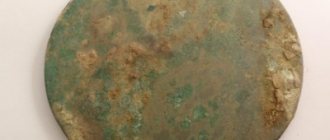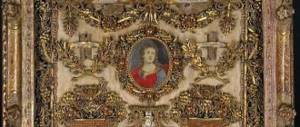HISTORY OF THE DEVELOPMENT OF MATHEMATICS Completed by 10th grade students Leonova S. Vasilenko D. - presentation
HISTORY OF THE DEVELOPMENT OF MATHEMATICS Completed by 10th grade students Leonova S. Vasilenko D.
The oldest mathematical activity was counting. An account was necessary to keep track of livestock and conduct trade. Some primitive tribes counted the number of objects by correlating them with various parts of the body, mainly fingers and toes. A rock painting that has survived to this day from the Stone Age depicts the number 35 as a series of 35 finger sticks lined up in a row. The first significant advances in arithmetic were the invention of the four basic operations: addition, subtraction, multiplication and division. The first achievements of geometry are associated with such simple concepts as straight lines and circles. Further development of mathematics began around 3000 BC. thanks to the Babylonians and Egyptians.
BABYLONIA AND EGYPT Babylonia. Our knowledge of the Babylonian civilization comes from well-preserved clay tablets covered with cuneiform texts that date back to 2000 BC. and up to 300 AD The mathematics on the cuneiform tablets was mainly related to farming. Arithmetic was used in exchanging money and paying for goods. Arithmetic and geometric problems arose in connection with the construction of canals, granaries and other public works. A very important task of mathematics was the calculation of the calendar, since the calendar was used to determine the dates of agricultural work and religious holidays.
The Babylonians compiled tables of reciprocal numbers (which were used in performing division). Tables of squares and square roots. Tables of cubes and cube roots. They knew a good approximation of the number. They used the quadratic formula to solve quadratic equations and could solve some special types of problems involving up to ten equations in ten unknowns, as well as certain varieties of cubic and quartic equations. Only the tasks and the main steps of the procedures for solving them are depicted on clay tablets. As for algebraic problems, they were formulated and solved in verbal notation.
Around 700 BC The Babylonians began to use mathematics to study the movements of the Moon and planets. This allowed them to predict the positions of the planets, which was important for both astrology and astronomy. In geometry, the Babylonians knew 1. the proportionality of the corresponding sides of similar triangles. 2. Pythagorean theorem 3. an angle inscribed in a semicircle is a right angle. 4.calculated the areas of simple plane figures, regular polygons, and volumes of simple bodies. 5. The Babylonians considered the number p to be 3.
Ancient Babylonian cuneiform text. The depicted section contains 16 problems with solutions related to the calculation of dams, shafts, and wells. The problem provided with a drawing relates to the calculation of a circular shaft. (British museum)
Ancient Babylonian cuneiform text containing a list of right triangles with rational sides. Square with diagonals. Ancient Babylonian cuneiform text.
Egypt Our knowledge of ancient Egyptian mathematics is based mainly on two papyri dating from about 1700 BC. The mathematical information presented in these papyri dates back to an even earlier period - c. BC. The Egyptians used mathematics to: calculate the weight of bodies; crop areas and grain storage volumes; the amount of taxes and the number of stones required for the construction of certain structures. In the papyri one can also find problems related to determining the amount of grain needed to prepare a given number of glasses of beer, as well as more complex problems. But the main area of application of mathematics was astronomy.
Ancient Egyptian writing was based on hieroglyphs. The number system of that period was inferior to the Babylonian one. The Egyptians used a non-positional decimal system, in which the numbers 1 to 9 were indicated by the corresponding number of vertical bars. With the advent of papyrus, the so-called hieratic cursive writing arose, which, in turn, contributed to the emergence of a new numerical system. Fractions were written as a sum of fractions with a numerator equal to one. With such fractions, the Egyptians performed all four arithmetic operations, but the procedure for such calculations remained very cumbersome.
Geometry among the Egyptians came down to calculating the areas of rectangles, triangles, trapezoids, circles, as well as formulas for calculating the volumes of certain bodies.
Part of the Mathematical Papyrus of Ahmes (also known as the Rhind Papyrus; c. BC) includes conditions and solutions to 84 problems encountered in practice.
A fragment of a leather scroll containing a list of simple relationships between fractions. Found near the mortuary temple of Ramses II in Thebes. Dated to around 1700 BC Scribe. Limestone. Around 2500 BC Scribes held an important position in society due to their ability to manipulate numbers to solve practical problems.
The image on the tomb of Djeserkere-sonb in Thebes (Upper Egypt). Dates from 1567–1310. BC.
Greek mathematics Classical Greece. From a 20th century point of view. The founders of mathematics were the Greeks of the classical period (6th–4th centuries BC). Mathematics, as it existed in the earlier period, was a set of empirical conclusions. The Greeks' insistence on deductive proof was an extraordinary step. No other civilization has reached the idea of arriving at conclusions solely on the basis of deductive reasoning, starting from explicitly stated axioms. Mathematicians and philosophers (often these were the same people) belonged to the highest strata of society, where any practical activity was considered an unworthy occupation. Mathematicians preferred abstract reasoning about numbers and spatial relationships to solving practical problems. Mathematics was divided into arithmetic - the theoretical aspect and logistics - the computational aspect. Logistics was left to the freeborn of the lower classes and slaves.
The deductive character of Greek mathematics was fully formed by the time of Plato and Aristotle. The invention of deductive mathematics is usually attributed to Thales of Miletus (c. 640–546 BC), who, like many ancient Greek mathematicians of the classical period, was also a philosopher. It has been suggested that Thales used deduction to prove some results in geometry, although this is doubtful.
Another great Greek whose name is associated with the development of mathematics was Pythagoras (c. 585–500 BC). Pythagoras founded the Pythagorean movement, which flourished in the period c. 550–300 BC The Pythagoreans created pure mathematics in the form of number theory and geometry. They represented whole numbers in the form of configurations of dots or pebbles, classifying these numbers in accordance with the shape of the resulting figures (“curly numbers”). The word "calculation" (calculation, calculation) originates from the Greek word meaning "pebble". Numbers 3, 6, 10, etc. The Pythagoreans called it triangular, since the corresponding number of pebbles can be arranged in the form of a triangle, the numbers 4, 9, 16, etc. – square, since the corresponding number of pebbles can be arranged in the form of a square, etc.
One of the most prominent Pythagoreans was Plato (c. 427–347 BC). Plato was convinced that the physical world can only be understood through mathematics. It is believed that he is credited with inventing the analytical method of proof. It is generally accepted that Plato's followers invented a method of proof called “proof by contradiction.” Aristotle, a student of Plato, occupies a prominent place in the history of mathematics. Aristotle laid the foundations of the science of logic and expressed a number of ideas regarding definitions, axioms, infinity and the possibility of geometric constructions.
The greatest of the Greek mathematicians of the classical period, second only to Archimedes in the importance of his results, was Eudoxus (c. 408–355 BC). It was he who introduced the concept of magnitude for such objects as line segments and angles. Having the concept of magnitude, Eudoxus logically and strictly substantiated the Pythagorean method of dealing with irrational numbers. The work of Eudoxus made it possible to establish the deductive structure of mathematics on the basis of explicitly formulated axioms. He also took the first step in the creation of mathematical analysis, since it was he who invented the method of calculating areas and volumes, called the “exhaustion method.” Eudoxus also owns the first astronomical theory that explains the observed movement of the planets.
Apollonius (c. 262–200 BC) lived during the Alexandrian period, but his main work is in the spirit of the classical tradition. His proposed analysis of conic sections - circle, ellipse, parabola and hyperbola - was the culmination of the development of Greek geometry. Apollonius also became the founder of quantitative mathematical astronomy.
Eratosthenes (c. 275–194 BC) found a simple method for accurately calculating the circumference of the Earth, and he also created a calendar in which every fourth year has one more day than the others. The astronomer Aristarchus (c. 310–230 BC) wrote an essay On the sizes and distances of the Sun and Moon, which contained one of the first attempts to determine these sizes and distances; Aristarchus' work was geometric in nature.
Alexandrian period. During this period, which began around 300 BC, the nature of Greek mathematics changed. Alexandrian mathematics arose from the fusion of classical Greek mathematics with the mathematics of Babylonia and Egypt. In general, mathematicians of the Alexandrian period were more inclined to solve purely technical problems than to philosophy. The great Alexandrian mathematicians - Eratosthenes, Archimedes, Hipparchus, Ptolemy, Diophantus and Pappus - demonstrated the power of the Greek genius in theoretical abstraction.
Archimedes was the greatest mathematical physicist of antiquity. He used geometric considerations to prove theorems of mechanics. His essay On Floating Bodies laid the foundations of hydrostatics. According to legend, Archimedes discovered the law that bears his name, according to which a body immersed in water is subject to a buoyant force equal to the weight of the liquid displaced by it. While bathing, while in the bathroom, and unable to cope with the joy of discovery that gripped him, he ran out naked into the street shouting: “Eureka!” (“Opened!”)
The highest achievement of Alexandrian mathematicians was the creation of quantitative astronomy. We owe the invention of trigonometry to Hipparchus (c. 161–126 BC). His method was based on a theorem stating that in similar triangles the ratio of the lengths of any two sides of one of them is equal to the ratio of the lengths of two corresponding sides of the other. The ratios of the lengths of the other sides of a right triangle are called cosine and tangent of angle A. Hipparchus invented a method for calculating such ratios and compiled tables of them. He was able to calculate the length of the Earth, its great circumference and the distance to the Moon. Hipparchus determined the length of the solar year with an error of only 61/2 minutes; It is believed that it was he who introduced latitude and longitude.
Greek trigonometry and its applications to astronomy reached its peak in the Almagest of the Egyptian Claudius Ptolemy (died 168 AD). The Almagest presented the theory of the movement of celestial bodies, which prevailed until the 16th century, when it was replaced by the theory of Copernicus. Ptolemy sought to build the simplest mathematical model, realizing that his theory was just a convenient mathematical description of astronomical phenomena consistent with observations. Copernicus's theory prevailed precisely because it was simpler as a model.
INDIA AND ARABS The Indians became the successors of the Greeks in the history of mathematics. Indian mathematicians did not engage in proofs, but they introduced original concepts and a number of effective methods. It was they who first introduced zero both as a cardinal number and as a symbol of the absence of units in the corresponding digit.
Mahavira (850 AD) established rules for operations with zero, believing, however, that dividing a number by zero leaves the number unchanged. The correct answer for the case of dividing a number by zero was given by Bhaskara, who also gave the rules for operating with irrational numbers. The Indians introduced the concept of negative numbers (to represent debts).
MIDDLE AGES AND RENAISSANCE Medieval Europe. Astrology was considered the most important branch of mathematics in the Middle Ages; astrologers were called mathematicians. And since medical practice was based primarily on astrological indications or contraindications, doctors had no choice but to become mathematicians. The translation of works of the Ancient World and the East into Latin contributed to the rise of mathematical research. All the great scientists of the time admitted that they drew inspiration from the works of the Greeks. The first European mathematician worth mentioning was Leonardo of Pisa (Fibonacci). He introduced Europeans to Indo-Arabic numerals and methods of calculation, as well as Arabic algebra.
B. Pascal I. Barrow R. Descartes
Revival. Among the best geometers of the Renaissance were artists who developed the idea of perspective. The artist Leon Battista Alberti (1404–1472) introduced the concepts of projection and section. Projective geometry emerged. Its founder, J. Desargues (1593–1662), with the help of proofs based on projection and section, unified the approach to various types of conic sections, which the great Greek geometer Apollonius considered separately.
THE BEGINNING OF MODERN MATHEMATICS John Wallis Isaac Newton
Decimal fractions and rules for arithmetic operations with them were introduced. A real triumph was the invention of logarithms in 1614 by J. Napier. From the beginning of the 16th century. Irrational numbers began to be used more widely. R. Descartes (1596–1650) and John Wallis (1616–1703) believed that irrational numbers are valid on their own, without reference to geometry. In the 16th century Controversy continued over the legality of introducing negative numbers. Complex numbers were finally recognized only at the beginning of the 19th century, when mathematicians became familiar with their geometric representation.
Advances in algebra. In the 16th century Italian mathematicians N. Tartaglia (1499–1577), S. Dal Ferro (1465–1526), L. Ferrari (1522–1565) and D. Cardano (1501–1576) found general solutions to equations of the third and fourth degrees. To make algebraic reasoning and notation more precise, many symbols were introduced, including +, –, ´,, =, > and





